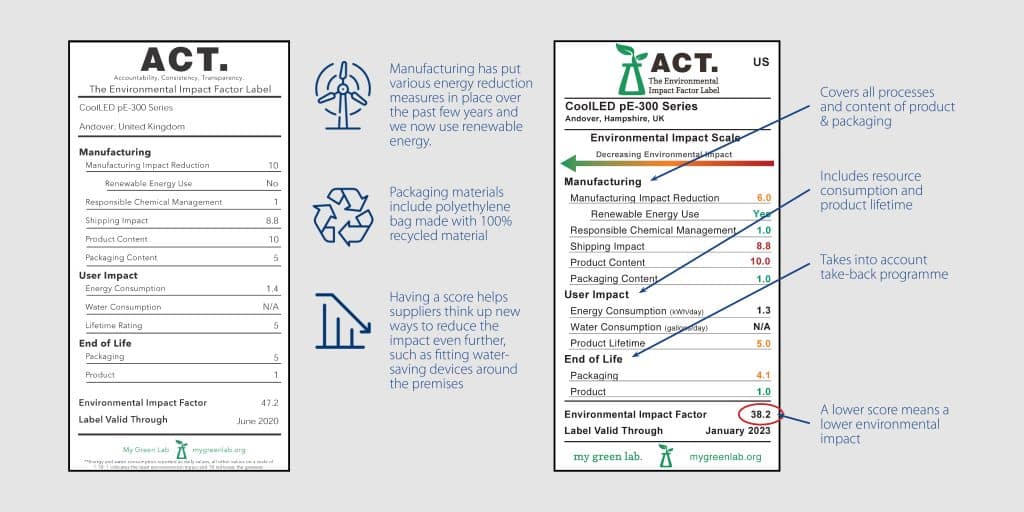Becoming ‘Greener’ with Light Microscopy
Sponsored by CoolLED, on 11 October 2023
Working in a laboratory, you can’t help but notice how everyday tasks can impact the environment – from reliance on single-use plastics to energy-hungry equipment. While this might seem unavoidable, sustainable options are becoming widely available. In fact, many technologies and initiatives now exist to support the scientific community on the journey towards sustainable laboratories.
When it comes to widefield fluorescence microscopy, LED illumination systems offer significant performance advantages compared to traditional metal halide and mercury lamps, in terms of controllability, stability and temporal resolution. But did you know they are also much better for the environment? This is largely down to two factors: conserving energy and avoiding mercury.
Conserving Energy
An independent comparison study found that over 25,000 hours of use, a mercury lamp consumed 10 times more energy than a CoolLED LED Illumination System.1 This may seem surprising, but it is not just about energy efficiency (although both fluorescence and transmitted LED illumination systems are significantly more energy efficient). Energy is also conserved by avoiding the warm-up time required before a mercury or metal halide lamp can be used, and the cool down period before it can be safely used again. Instead, microscopists can quickly switch LEDs on and off as required, and illumination is immediately stable and ready for use. This is a game changer for laboratories who find themselves leaving a lamp switched on all day to ensure availability when required. Considering the recent rise in energy prices, financial benefits are substantial. Although many laboratories and microscopy facilities do not pay directly for energy consumption, some institutes offer financial support for energy efficient equipment, which are sometimes known as ‘Green Grants’.
No More Mercury
The toxic nature of mercury needs no introduction, but unfortunately this environmentally damaging substance is found in both metal halide and mercury lamps. Financial factors are also at play here, since disposing of old mercury lamps incurs extra cost. In fact, countries are moving towards banning mercury lamps altogether, since a viable alternative now exists (in the form of LEDs).2 We would argue that LED technology for fluorescence illumination has now progressed beyond a viable alternative, and the good news is that scientists can make a sustainable choice while enjoying performance advantages.
A Score for Sustainability
While sustainable light sources and other laboratory equipment are becoming increasingly available, it can be challenging to justify the sustainability benefits a piece of equipment can bring to the department. To help organisations understand the environmental impact of equipment and make sustainable purchasing choices, the not-for-profit organisation My Green Lab developed the ACT Label. ACT stands for Accountability, Consistency and Transparency, and is like an eco-nutrition label for lab products. Each label provides a score which reflects the complete environmental impact of manufacturing, using, and disposing of a product and its packaging (Figure 1). This is currently available for the CoolLED pE-300 Series and new pE-400 Series LED Illumination Systems (Figure 2), and an open-access database of all ACT Labelled equipment is available at https://act.mygreenlab.org.

By having a score, this also helps suppliers focus on ways to reduce their impact even further and become increasingly sustainable. For example, at CoolLED we recently reduced our ACT score through improved manufacturing processes and switching to 100% recycled plastic packaging materials. Initiatives such as the ACT Label therefore reach further than a single product and establish an actionable approach towards sustainability.

Towards a Sustainable Future
Sustainability is increasingly important to consider in the laboratory, and many institutes now have sustainability officers to offer extra guidance and encouragement. This also points towards a change on the horizon as pressure is set to increase from funding bodies. For example, the UK Research and Innovation (UKRI) Environmental Sustainability Strategy details a plan to consider environmental sustainability as part of funding decisions, grant and training terms.3
Taken together, a picture of the not-so-distant future emerges where organisations support their laboratory staff to become more sustainable in their behaviour and equipment, which in turn helps to secure grants. However, knowing where to start with improving sustainability might seem overwhelming, and here is our advice:
- If purchasing a new microscope, ask your supplier about the light source and whether they can supply an LED illumination system instead of a metal halide lamp.
- When making a purchase decision, even for consumables, check the ACT Label Database for a certified alternative, or ask your supplier about their sustainability initiatives.
- Become a My Green Lab ambassador – there are many simple adjustments you might be able to achieve without extra cost.
- Join the LEAF Programme (Laboratory Efficiency Assessment Framework).
References
- Green Light Laboratories (2017). mercury versus LED study. Available at: www.coolled.com/wp-content/uploads/2019/08/Green-Light-Laboratories-Mercury-versus-LED.pdf (downloaded 28 April 2021)
- United Nations Environmental Programme (2017). Minamata Convention on Mercury. Available at: http://www.mercuryconvention.org/Portals/11/documents/Booklets/COP1%20version/Minamata-Conventionbooklet-eng-full.pdf (downloaded 28 April 2021)
- UK Research and Innovation (2020). UKRI Environmental Sustainability Strategy. Available at: https://www.ukri.org/wp-content/uploads/2020/10/UKRI-050920-SustainabilityStrategy.pdf (downloaded 28 April 2021)



 (No Ratings Yet)
(No Ratings Yet)